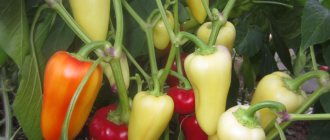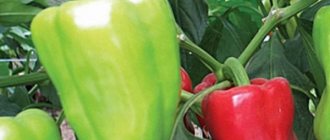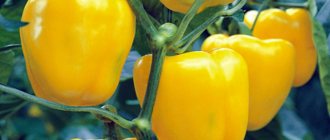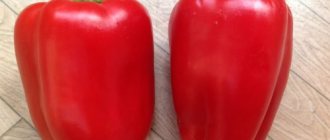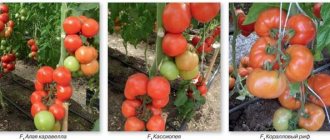The summer season will begin very soon, and all gardeners are rushing to purchase what they need. Everyone who sows seedlings acquires seeds of tomatoes, cucumbers, and peppers. It is the latter that we will talk about today. How not to make a mistake when the store has such a large assortment? Experience comes with practice and knowledge, which we can give you. Today we are looking at pepper again - this is Ali Baba. Let's find out its characteristics and description of the variety. By tradition, we will look at reviews and photos, learn about productivity, agricultural technology and pests.
Description and characteristics of the variety
Bell pepper Ali Baba is included in the early ripening category; full ripening is observed 90-105 days after germination. The vegetable grows in compact low-growing bushes, the length of the shoots does not exceed 40-45 cm. The pepper is well leafy, spreading is moderate. The leaves are dark green, well cover the fruits in the heat from the scorching sun.
The agro variety is characterized by friendly ripening. The fruits have an attractive appearance. What are the signs of peppers:
- flattened, conical shape;
- large sizes, average weight from 150 to 300 g;
- pointed nose;
- the color changes as it ripens (at first the fruits are green, then creamy yellow, and at the stage of full ripeness they are deep red);
- walls thickened to 6-8 mm;
- the surface is durable, glossy, smooth;
- the flesh is fleshy and juicy.
Peppers have an exquisite taste and aroma. They are cut into salads, casseroles, stuffed dishes are prepared from them, put in borscht and soups, frozen whole and as part of a platter.
Diseases
Ali Baba pepper has stable immunity to most nightshade diseases. However, under unfavorable weather conditions, insufficient care and failure to follow simple rules of agricultural technology, peppers can still get sick.
Attention! It should be taken into account that it is easier, cheaper and simpler to prevent a disease than to treat it later.
Therefore, it is healthier and more convenient to take preventative measures to prevent disease when growing peppers than to treat a diseased plant or completely get rid of it, losing the harvest.
To prevent the plant from becoming infected with soil rot and fungal diseases, you need to:
- disinfect the soil before planting seedlings in it: you can pour boiling water over the soil and spray it with fungicides;
- do not thicken the plantings; maintain the required distance between the bushes;
- if peppers are grown in greenhouses, the necessary temperature and light conditions should be observed; if there is not enough light, it is good to illuminate the plants with special phytolamps;
- if there is not enough light, it is good to supplement the plants with special phytolamps;
- maintain the level of humidity, avoiding excessive moisture in the room and on the soil;
- greenhouses need to be ventilated regularly;
- keep the room clean - disinfect it after harvesting and before planting seedlings, disinfect it by fumigating it with sulfur bombs from diseases and pests, wash the room specially. means;
- follow the rules of crop rotation (both in open and closed ground);
- Spray the bushes periodically with fungicides or herbal decoctions, infusions, and solutions.
Landing
The variety is grown through seedlings. Use separate containers and cups. If planted in common boxes, adhere to a step of 2-3 cm.
The dates for starting planting work are the 2nd-3rd decade of February, the first half of March.
The seeds are calibrated, disinfected, treated with a stimulant solution, and planted to a depth of 2 cm. For the first 10 days, the containers are kept under film and kept at a temperature of 25-27 degrees.
After germination, the shelter is removed, lighting is maintained from 8 a.m. to 8 p.m. using phytolamps. Before planting in a permanent place, hardening is carried out at 10 degrees.
Pests
Pepper pests can affect plants if unfavorable weather conditions occur, crop rotation rules are violated, or other nightshades are planted next to them. Ali Baba peppers are mainly threatened by slugs, aphids and mites. To prevent pests from entering your area or to minimize their invasion, it is useful to take certain simple measures:
- Spraying the bushes with herbal infusions will help against aphids. For infusions, it is useful to use potato tops, tomatoes, onion peels, yarrow, tansy or wormwood; can be sprayed with a solution of wood ash or tobacco dust (1 glass of ash or tobacco per 10 liters of hot water). Leave the solution for a day, strain before use, add soap (liquid soap is possible). Spray the plants once every 5 days.
Advice! To add to infusions, decoctions, solutions, you can prepare a soap concentrate: dissolve grated laundry soap in water, keep in a separate container, add to the infusion or decoction needed for spraying as needed.
- Slugs are active in the evenings and at night. The beds must be kept clean, weeds must be regularly removed, loosened by scattering ground pepper, mustard, lime, chalk, and coffee grounds over the soil. It is good to sow parsley in the spaces between the rows, which slugs do not like.
- For ticks, spraying the bushes with infusions of chopped onion or garlic, dandelion, and adding liquid soap to the infusion helps a lot. The reverse side of the leaves should be treated especially. Among the preparations you can use Fitoverm, Iskra, Inta-Vir and other insecticides.
It is much easier to initially protect pepper bushes from pests:
- do not plant other nightshades next to peppers;
- do not plant peppers in areas where tomatoes, potatoes, physalis, and nightshade grew before;
- plant legumes, parsley, herbs, calendula, marigolds and other garden plants next to the pepper.
If you follow the necessary preventive measures, Ali Baba pepper will delight you with a good harvest of tasty and sweet fruits.
Features of cultivation
Breeders did their best when breeding this variety. Ali Baba pepper adapts perfectly to any climatic conditions of the Russian Federation. It tolerates uneven watering without damage and is easy to care for.
Good predecessors for it are: carrots, beets, cabbage, pumpkins, legumes, with the exception of beans. Do not plant peppers next to cucumbers.
The most important thing for the Ali Baba variety is properly grown seedlings. Seeds should be planted in mid-February, slightly grown seedlings should be hardened off. The cultivation technology is similar to that for tomatoes.
Plant seedlings in the ground at a distance of 50x50 cm, preferably in a square nesting method, in a sunny, open area, but protected from drafts and northern winds.
The Ali Baba variety attracts with its unpretentiousness, resistance to adverse weather and climatic conditions, early ripening and friendly yield. The fruits tolerate transportation well and have good keeping quality. Usually, Ali Baba pepper does not sit out - it is eaten immediately. That is why it is so popular among gardeners and farmers.
Pepper "Ali Baba": a variety with universal cultivation
The summer season will begin very soon, and all gardeners are rushing to purchase what they need. Everyone who sows seedlings acquires seeds of tomatoes, cucumbers, and peppers. It is the latter that we will talk about today. How not to make a mistake when the store has such a large assortment? Experience comes with practice and knowledge, which we can give you. Today we are looking at pepper again - this is Ali Baba. Let's find out its characteristics and description of the variety. By tradition, we will look at reviews and photos, learn about productivity, agricultural technology and pests.
general description
Among the various varieties, our current one can take one of the highest places.
That is, “Ali Baba” is praised by summer residents; they have already tested it on their plots. It was bred in Russia, therefore the variety is most adapted to the country’s changing climate. The highest yields are obtained in the temperate zone and in the south, but northern regions can also grow this variety. Of course, in such places it is preferable to use greenhouses.
Sowing seedlings begins early, but already at the beginning of summer you can enjoy the vitamins. “Ali Baba” cannot be called capricious in cultivation, and besides, it is compact.
We will tell you all the techniques, and then we advise you to find out in detail about the indicators - they are decent.
Varietal characteristics
- Sweet pepper "Ali Baba" is early ripening - the first harvest is produced 100-105 days after the seedlings emerge.
- Light-loving - light should fall on the seedlings approximately 12 hours a day, from 8 am.
- The bushes are very compact - only 45 cm.
- The number of leaves is medium, they are rich green in color.
- In the technical ripeness phase, the pepper is soft green, then orange and, when fully ripe, bright and red.
- The pulp is not very thick - 5 mm, but the variety is juicy and tasty.
- Unpretentious to grow.
- Suitable for cultivation in greenhouses and open ground.
- Has a universal table purpose.
- The fruits are drooping, that is, they grow downwards, the shape is a cone with a sharp tip.
- The peculiarity of this variety is that the stalk is not pressed inside the cone.
- Stores and transports well.
- Fruit weight is up to 350 grams, one bush produces up to 10 pieces. Large-fruited variety.
- Resistant to major pepper diseases.
From the varietal characteristics we can clearly see that the “Ali Baba” sweet pepper can become a permanent resident of the garden bed, especially if you have very little space or only a small greenhouse. We advise you to take a closer look at this pepper.
Diseases and pests
As we already indicated a little earlier, the variety is resistant to diseases, which is very good. Diseases destroy the crop quickly - all efforts may be in vain. Therefore, for everyone who cannot spend a lot of time in the garden beds and does not understand the ailments of crops, it is better to immediately choose resistant varieties. But it is still important to observe crop rotation and prepare the soil well on the site.
It cannot be said that this variety is very bothered by insects, but still it does not change from year to year, and various factors can play a role here - weather, the presence of other crops, the condition of neighboring plots. For example, if you have an abandoned field nearby, then parasites will probably want to feast on the crops in your garden.
This means that you need to monitor and periodically carefully examine the bushes from all sides. Aphids, mites, Colorado potato beetle larvae or butterflies can settle on the inside of the leaves. You need to carry out the treatment immediately - if the attack happened before flowering, then you can buy insecticides; if the pepper is already blooming and bearing fruit, then use biological preparations and traditional methods.
Advantages and disadvantages
So, let’s summarize the description of the “Ali Baba” sweet pepper variety, identify weaknesses, if any, and combine the advantages.
- productivity, fruit quality, relative unpretentiousness;
- universal cultivation and table use;
- compactness;
- the stalk is at the top, it is convenient to remove it;
- low foliage, that is, light will penetrate well and the crop will ripen faster.
- possible pests;
- demands on light;
- not very thick pulp - less suitable for stuffing than thick-walled varieties.
Pepper Ali Baba
Among vegetable crops, sweet bell pepper occupies a significant place. And although it is more sensitive to the climatic characteristics of a particular area, selection, especially domestic, works wonders. This crop is now growing more and more successfully every year in places where, it would seem, the climate is completely unsuitable for it - cold, harsh.
A variety of Russian selection. Ali Baba was bred for cultivation in open ground, in greenhouses, under low film covers. Grows best in temperate climate zones.
Pepper is a very heat-loving crop, more demanding than tomatoes. Among the many varieties, Ali Baba pepper stands out. This variety is grown with great success even on an industrial scale. It grows and bears fruit successfully in the northern regions, where it is grown indoors. Ali Baba pepper is popular not only among gardeners, but also among farmers. It is loved for its unpretentiousness and early harvest.
Characteristics and description of the variety
There are many varieties of bell peppers today. Which one to choose, so that it suits your taste, so that it is not capricious, so that it produces a good harvest - these are the questions gardeners ask themselves when thinking about buying seeds. To make it easier to make the right choice and not regret it, you need to know the characteristics of a particular variety.
- early ripening variety;
- low growing bush – 40-45 cm;
- densely leafy bush with dark green leaves;
- branch spread is average;
- resistant to sudden temperature changes;
- fruits ripen 90-100 days after emergence;
- peppers are tilted with their noses down;
- the yield is high: with sufficient care, you can collect 8-10 peppers from the bush;
- The fruits ripen almost simultaneously.
Basic rules for caring for Ali Baba peppers
To get a good harvest of this crop, it is necessary to provide the sweet pepper bushes with appropriate conditions for growth and care. Since this plant prefers light types of soil, the soil must be well fluffed and fertilized before planting.
The Ali Baba variety needs the following care:
- Regular watering of bushes. For this procedure, it is recommended to use pre-settled and heated water. It is optimal to allocate about 1-2 liters of liquid for each bush.
- Top watering of pepper is allowed only before the budding period. After the first flowering and until harvest, water is supplied to the bushes exclusively at their base to avoid moisture getting on the foliage.
- To obtain large and juicy fruits, it is recommended to fertilize peppers with mineral and organic fertilizers. Such compositions are carefully applied under the bush no more than 2 times a month.
- Regular weeding and loosening of the soil.
If you carry out the procedure of mulching the soil, it is possible not only to reduce the frequency of weeding, but also to optimize the temperature regime and the amount of moisture in the soil. If you follow the tips listed above, sweet peppers will delight you with their juicy and bright fruits from mid-summer to early autumn.

